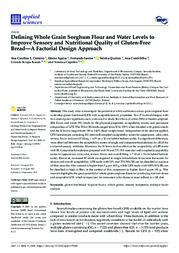Defining whole grain sorghum flour and water levels to improve sensory and nutritional quality of gluten-free bread: a factorial design approach.
Defining whole grain sorghum flour and water levels to improve sensory and nutritional quality of gluten-free bread: a factorial design approach.
Author(s): CENTENO, A. C. L.; AGUIAR, E.; SANTOS, F.; QUEIROZ, V. A. V.; CONTI-SILVA, A.; KRUPA-KOZAK, U.; CAPRILES, V.
Summary: This study aims to investigate the potential of white and bronze whole-grain sorghum flour to develop gluten-free bread (GFB) with acceptable sensory properties. Two 22 factorial designs, with two central point repetitions each, were used to study the effects of white (WS) or bronze sorghum (BS) flours and water (W) levels on the physical properties, acceptability scores, and proximate composition of GFB. The WS or BS levels ranged from 50 to 100% when blended with potato starch, and the W levels ranged from 100 to 140% (flour weight basis). Independent of the amount applied, GFB formulations containing BS were well accepted (acceptability scores for appearance, color, odor, texture, flavor and overall liking ≥ 6.29 on a 10 cm hybrid hedonic scale). No significant differences were observed between the acceptability scores of single and composite formulations for all of the evaluated sensory attributes. Moreover, the W levels had no effect on the acceptability of GFB made with BS. Composite formulations prepared with 50 and 75% WS were also well accepted (acceptability scores for appearance, color, odor, texture, flavor, and overall liking ≥ 7.43 on a 10 cm hybrid hedonic scale). However, increased W levels are required in single formulations to increase the scores for texture and overall acceptability. GFB made with 50% and 75% WS/BS can be classified as a source of fiber since the fiber content is higher than 3 g per 100 g, while GFB made with 100% WS/BS can be classified as high in fiber, as the content of this component is higher than 6 g per 100 g. This research highlights the great potential of whole-grain sorghum flours for producing nutrient-dense and acceptable GFB, which is important for consumers who choose or must adhere to a GF diet.
Publication year: 2021
Types of publication: Journal article
Unit: Embrapa Maize & Sorghum
Observation
Some of Embrapa's publications are published as ePub files. To read them, use or download one of the following free software options to your computer or mobile device. Android: Google Play Books; IOS: iBooks; Windows and Linux: Calibre.
Access other publications
Access the Agricultural Research Database (BDPA) to consult Embrapa's full library collection and records.
Visit Embrapa Bookstore to purchase books and other publications sold by Embrapa.

